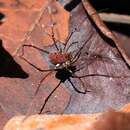The Manaosbiidae are a family of neotropical harvestmen within the suborder Laniatores.
Name
The name of the type genus is combined from Manaus and Ancient Greek bios "living".[1]
Description
Body length ranges from about three to ten millimeters. Most species are dark brown with black mottling. Appendages are in general much lighter, often with dark rings.[1]
Distribution
The Manaosbiidae occur south from Panama, with a southern limit in Mato Grosso do Sul (Brazil). They inhabit lowland Amazonian rainforest up to submontane Andean forests, dry forests in Central America, and riparian forests in Brazil.[1]
Relationships
The relationship of Manaosbiidae with other families within the Gonyleptoidea is unclear.[1]
Species
Manaosbiinae
-
Barrona Goodnight & Goodnight, 1942
-
Rhopalocranaus albilineatus Roewer, 1932 – Trinidad
-
Rhopalocranaus apiculatus Roewer, 1932 – Brazil
-
Rhopalocranaus aspersus Roewer, 1932 – Brazil
-
Rhopalocranaus atroluteus Roewer, 1913 – Colombia
-
Rhopalocranaus bordoni Silhavy, 1979 – Venezuela
-
Rhopalocranaus crulsi Mello-Leitão, 1932
-
Rhopalocranaus festae Roewer, 1925 – Ecuador
-
Rhopalocranaus gracilis Roewer, 1913 – Venezuela
-
Rhopalocranaus limbatus (Schenkel, 1953) – Venezuela
-
Rhopalocranaus marginatus Roewer, 1913 – French Guiana, Brazil
-
Rhopalocranaus robustus Goodnight & Goodnight, 1942 — Guyana
-
Rhopalocranaus tenuis (Roewer, 1943) – Suriname
-
Rhopalocranaus tuberculatus Goodnight & Goodnight, 1942 – Guyana
-
Rhopalocranaus ypsilon Roewer, 1913 – Colombia
- unknown genus calcar (Roewer, 1943) – Venezuela
- unknown genus albituberculatus (Roewer, 1943) – Guyana
- unknown genus strinatii (V. Silhavy, 1979) – Venezuela
Footnotes
-
^ a b c d Kury, Adriano B. (2007): Manaosbiidae. Roewer, 1943. In: Pinto-da-Rocha et al. 2007: 210ff
References
- Joel Hallan's Biology Catalog: Manaosbiidae
-
Pinto-da-Rocha, R., Machado, G. & Giribet, G. (eds.) (2007): Harvestmen – The Biology of Opiliones. Harvard University Press ISBN 0-674-02343-9


